skip to main |
skip to sidebar
The Battlefield Line now operates two 'Santa' trains, alternately, on its line from Shackerstone to Shenton. One, with vestibule stock, is dubbed the 'Classic' train. In this train, Santa's Helpers take groups of passengers, in turn, to see Santa Claus in his Grotto, where the children receive an early Christmas present. The second train has corridor compartment stock and forms the 'De Luxe' train. On the De Luxe service, families or groups can book a private compartment provided with refreshments and Christmas Crackers and Santa makes a 'house call' at each compartment, distributing presents.
In December 2015, visiting locomotive 3205 (the 'Collett Goods') worked the 5-coach 'Classic' train and another visitor, 'Cumbria' (Hunslet 3794 'Austerity Tank'), hauled the 4-coach 'De Luxe' train. I'd first seen both engines at the The Battlefield Line Steam Gala in October 2015.
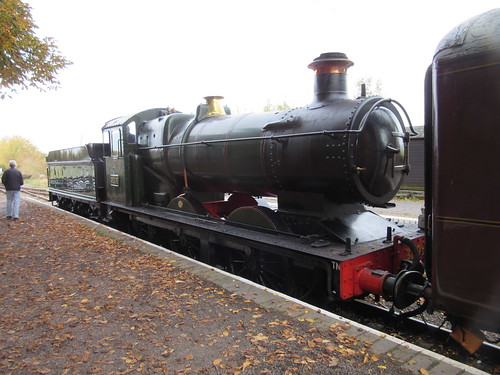 3205 Collett Goods at the Battlefield Line Steam Gala, October 2015
3205 Collett Goods at the Battlefield Line Steam Gala, October 2015
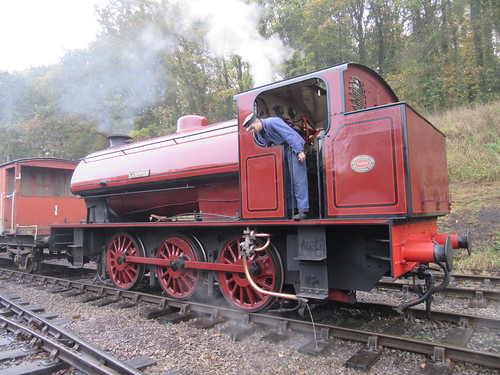 Hunslet 3794 'Cumbria' at the Battlefield Line Steam Gala, October 2015
Hunslet 3794 'Cumbria' at the Battlefield Line Steam Gala, October 2015
Events of Saturday 19th December 2015
I had been rostered to drive 'Cumbria'. For whatever reason, there was no fireman for 'Cumbria' although our trainee, James, was well-on with steam raising, under the watchful eye of Dave H. who was actually booked as Fireman on the 'Collett Goods'. The day was only saved by Dave agreeing to be fireman on both locomotives, since there was also a trainee fireman on the 'Collett Goods' to assist. Whilst trainee firemen can carry out most of the tasks, and are allowed to work under the supervision of the driver in 'station limits', once a locomotive leaves Shackerstone, there must be a registered fireman on the footplate.
The 'Collett Goods' was booked to make three trips to Shenton (leaving Shackerstone at 10 a.m., 1 p.m. and 4 p.m.) whilst 'Cumbria' was diagrammed to take two trips (at half past eleven and half past two). All trains were 'Sold Out'.
We came off shed with 'Cumbria' in good time to allow us to steam heat the 'De Luxe' train standing in platform 1. The day was overcast with intermittent rain. The 'Collett Goods' moved across to the head of the 'Classic' train in platform 2 shortly before departure time at 10:00. The 'Classic' train coaches have Electric Train Heating so can be warmed from an electric 'Shore Supply' before the locomotive arrives although, once coupled, the 'Collett Goods' provided conventional steam heating. The 10 o'clock departure left about ten minutes late, waiting for tardy passengers. We continued to warm our train whilst the other train travelled to Shenton and back and all the young people on that train had had a chance to meet Santa.
I think our first departure was about ten minutes late and we made very leisurely progress down the line to Market Bosworth. With a full train, Santa has his work cut out to see everybody so we stood for a while before carrying on to Shenton.
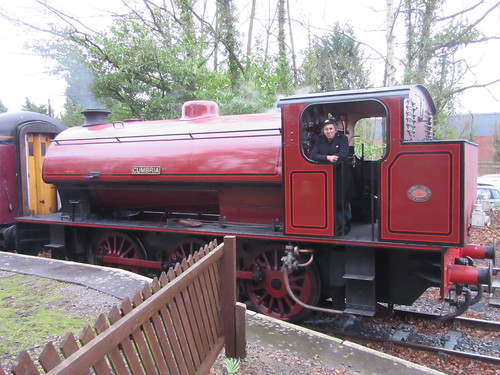 Jan relaxes on the footplate as 'Cumbria' pauses at Market Bosworth en route to Shenton with the 11:30 from Shackerstone.
Jan relaxes on the footplate as 'Cumbria' pauses at Market Bosworth en route to Shenton with the 11:30 from Shackerstone.
We made similarly pedestrian progress to Shenton. Then we had a flurry of activity as we uncoupled, ran round and "hooked on" again for the return, this time chimney leading. When we finally arrived back in platform 1 at Shackerstone, the one o'clock 'Classic' service was able to leave, but there was, once again, a slight delay as late-arriving passengers were rounded up. Once that train had left, we were able to run round our train, pausing at the water column at the south end of platform 2 to replenish our saddle tank. Once re-coupled, it was back to keeping the train warm ready for the 2.30 p.m. train.
Our second trip down the line was similarly uneventful (and slow). The day had remained overcast and, only three days before the Winter Equinox, we lit our paraffin headlamp before returning from Shenton. Of course, in the days of steam, the headlamp was principally a means of indicating to signalmen the type of train approaching. It's only modern high-intensity lights, now mandatory on Network Rail lines, that offer the driver any improved visibility ahead and that effect is limited.
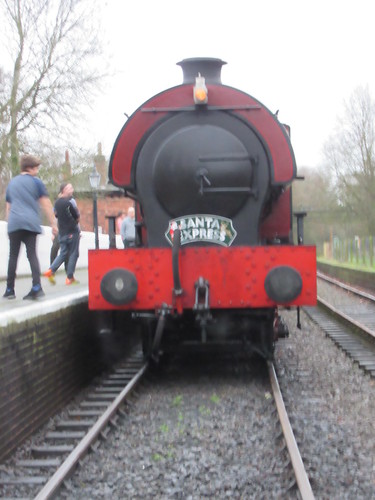
'Cumbria' (with headlamp lit) ready to return from Shenton.
We stood for some time at Market Bosworth, giving me a chance to take a picture of James on the footplate of 'Cumbria'. I also managed a shot of Santa himself making his way from compartment to compartment.
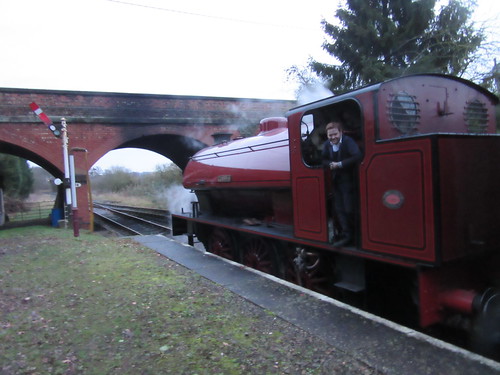 James smiles for the camera at Market Bosworth on our second return trip to Shackerstone.
James smiles for the camera at Market Bosworth on our second return trip to Shackerstone.
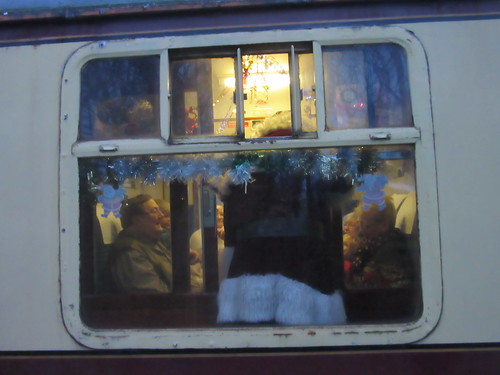 View from the platform at Market Bosworth as Santa visits each compartment of the 'De Luxe' train in turn.
View from the platform at Market Bosworth as Santa visits each compartment of the 'De Luxe' train in turn.
Eventually, we arrived back at Shackerstone, with a lot of happy passengers. A little later, the 'Collett Goods' left with the 4.00 p.m. departure - the last train of the day. My initial hopes that we might then put our engine to bed were dashed. With our 4-coach train blocking platform 1, there was no 'release road' to allow the 'Collett Goods' onto shed on his return and, in the absence of a suitable diesel shunting locomotive, and so we ran round our train and re-coupled. We remained there until the last train returned to platform 2. Our Guard also agreed to stay, to act as Shunter riding in the end of the stock. Once the last train had arrived, Leon, the signalman, "gave us the road", including permission to pass the Starting Signal (nowadays usually called the 'Section Signal') at danger sufficiently to get our 4-coach clear of the crossover and the two-disc ground signal which protects the crossover. The top disc 12 reads to platform 1, bottom disc 3 reads to platform 2. Signals by handlamp from both the Guard and Signalman let us know when we were 'clear'. The 'Collett Goods' wasted no time in uncoupling and, as soon as we'd drawn our train clear of platform 1, shunting into the shed.
The crossover road was reversed again and disc 12 cleared. The Guard, keeping lookout from what was now the leading vehicle, continuously gave lamp signals and I cautiously propelled the train back into platform 1. The Guard applied his handbrake, I 'squeezed up' to make sure the coupling was slack then James uncoupled. We followed the 'Collett Goods' into the shed and completed disposal of our engine.
More
I was back at the Battlefield Line on 'Santa' trains on Wednesday 23rd December 2015, driving '3205', as described here.
You can find all my posts on 'Santa Special' trains at the Battlefield Line and Peak Rail here.
My pictures
Battlefield Line 'Santa' Trains 2015
In an earlier post here, I described the service on 6th December 2015. I was there again on Sunday, 20th December 2015, this time with Phil M. as fireman. Having prepared 'Lord Phil', we moved across to Rowsley platform road and coupled onto the south end of the 7-coach train, giving us over an hour to perform 'carriage warming'.
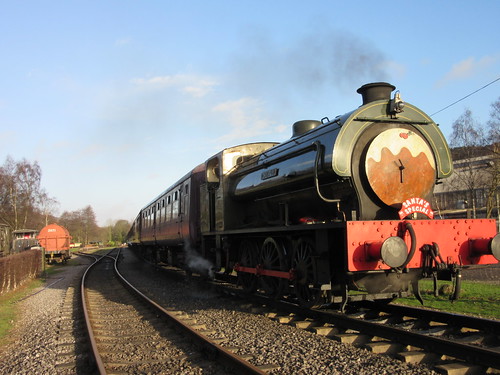 Steam heating the stock prior to the first departure from Rowsley.
Steam heating the stock prior to the first departure from Rowsley.
This time, the 'Class 31' had been left in the shed overnight but it came across and coupled up to the north end of the train to 'top and tail' in time for the first departure, which was a little delayed waiting for missing passengers.
We were still enjoying mild weather for December and the sun shone for most of the day but there was a wind which rather chilled the driver's side of the cab.
All tickets on the 'Santas' are pre-booked and we were told that all four trains were 'Sold Out'. In addition, Sunday Lunch was being served in the Palatine Set and, again, all seats were booked.
Of course, Santa Claus was there to welcome his young visitors, together with a reindeer, a cow and Peppa Pig.
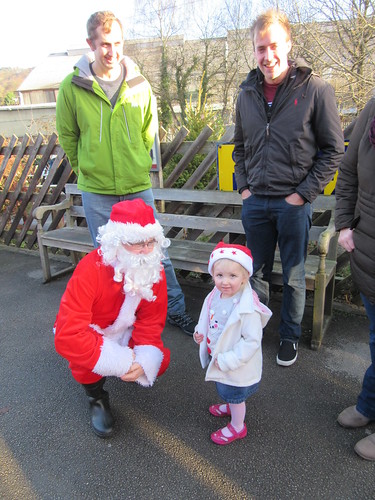
Santa greets a young visitor.
Once again a choir from Matlock Musical Theatre sang Christmas Carols on the platform at Rowsley as passengers boarded the train. Initially, there were six singers but other members strengthened the group later.
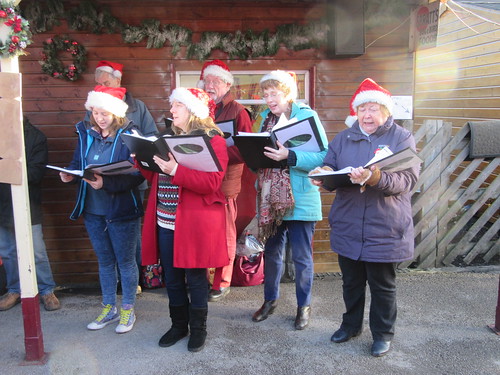 Carol Singers from Matlock Musical Theatre.
Carol Singers from Matlock Musical Theatre.
Phil drove the first trip while I fired. I seem to be loosing strength in my arms so that even firing the small grate on an 'Austerity' is getting harder. On the right-hand drive 'Austerity', the fireman should work from the left of the footplate, preferably using his right arm to push the shovel blade, leaving the left hand to support the shaft of the shovel. Unfortunately, I'm naturally left handed but on the small footplate of an 'Austerity' there's not enough room to fire from the 'wrong' side. Originally, most locomotives were right hand drive. The Great Western Railway remained right hand drive to the end, as did many countries which adopted right-hand running on double track. But in Britain, we've always used left-hand running on double track so the sighting of signals is easier if the driver is on the left and more modern locomotives tended to be left-hand drive. Since both left-hand and right-hand locomotives were in use (even within the same class sometimes), it was advantageous for fireman to be able to fire from either side - indeed, some driver's insisted that fireman stayed on their own side of the cab.
A few years ago the consummate railway professional Dick Hardy wrote to me about a day he'd spent firing 'Port Line' on a main line steam special, saying he found the firebox about a foot longer than he remembered from when he was younger. I know exactly what he meant.
I drove the three remaining trips and we worked through the day without incident which, of course, you always aim to do.
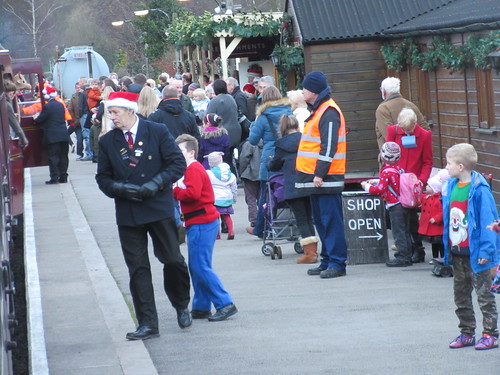 Rowsley Station.
Rowsley Station.
I don't think any of our departures from Rowsley were on time and the various speed restrictions don't give much scope for making up time 'on the road' but we made sure we didn't lose further minutes. There's a short video clip showing our final approach to Matlock Town, passing the Sainsbury's car park here. After watching the clip, the Back Button will return you to this blog.
On the final return from Matlock Town, Phil made sure our red tail lamp was lit. When we stopped at Darley Dale, the illuminated Christmas decorations showed up well.
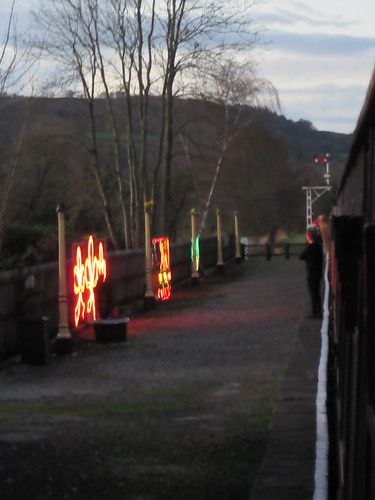
The last Down train at Darley Dale, showing the illuminated decorations.
To be able to check the gauges in the gathering gloom, Phil had donned his head-mounted 'miner's lamp'.
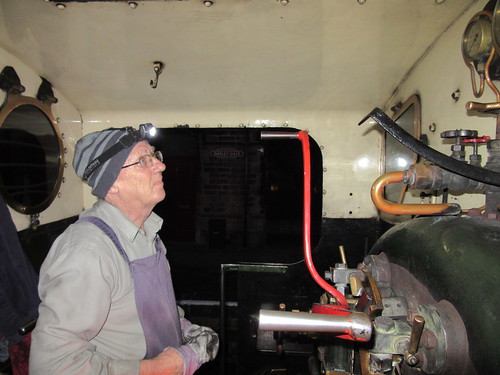 Flash photography shows Phil (with 'miner's lamp' ) checking the gauges.
Flash photography shows Phil (with 'miner's lamp' ) checking the gauges.
On arrival at Rowsley, we received the single line token from the station staff so that we could uncouple from the train and make our way, via the South End ground frame, to the loop and third line. At the North end, we then passed the token back to the diesel crew, allowing them to release the North End ground frame so that the 'Class 31' could make its way to the shed. We took 'Lord Phil' to the siding outside the shed, so that Chris could coal our bunker using the Bucket Loader. We then made our way to No. 1 road where we disposed and left 'Lord Phil' over the outside pit.
My pictures
Peak Rail 'Santa' Trains - 2015.
Bookings for Peak Rail's 'Santa Trains' in December 2015 have been very satisfactory.
Sunday, 6th December 2015
On the second day of the Santa service I was booked to drive, with Mike S. as fireman. Having prepared 'Lord Phil' and topped-up the bunker with coal, we coupled onto the south end of the 7-coach train ready to 'top and tail' with the 'Class 31' diesel-electric which had been left coupled at the north end overnight. We were nice and early so, before the first departure at 10:45, we had over an hour to perform 'carriage warming', supplying steam at 30 p.s.i. via the Reducing Valve to the heating system on each of the coaches. The weather was fairly mild for December and, although we had intermittent rain during the day, it was reasonably pleasant.
Rowsley Station had been decorated for Christmas and looked quite inviting. All tickets on the 'Santas' are pre-booked and volunteer helpers are always in demand to deal with the large number of passengers. Santa had a number of Elves and other helpers in attendance to assist in distributing presents to the children whilst the grown-ups enjoy mulled wine and a mince pie during the journey to Matlock Town and back.
As the passengers arrived, there was quite a pleasant atmosphere of anticipation, particularly when Santa patrolled the platform greeting the boys and girls together with professional entertainers who juggled, did magic and clowned. There was also a reindeer and a bear.
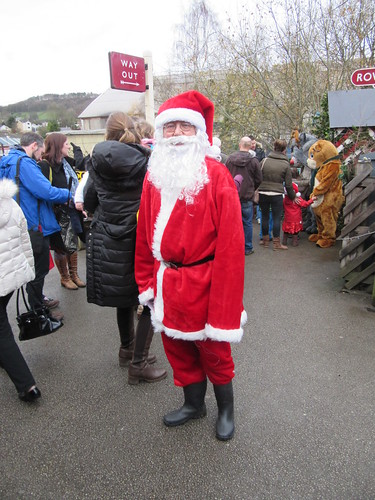
Santa poses for the camera before resuming greeting the visitors. The reindeer and bear are in the background.
In addition, a choir sang Christmas Carols on the platform at Rowsley as passengers boarded the train.
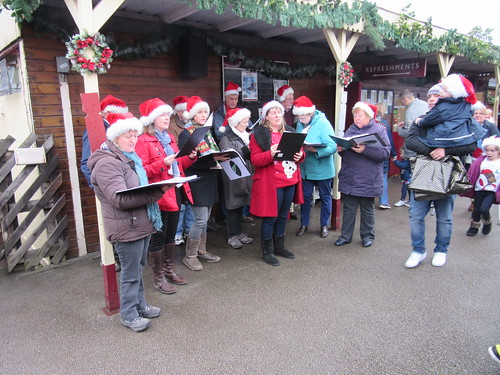 The choir perform in front of the decorated station buildings at Rowsley.
The choir perform in front of the decorated station buildings at Rowsley.
The two coaches marshalled next to the steam locomotive at the south end form the 'Palatine Set' comprising one full restaurant car and a restaurant/bar/kitchen car. The 'Palatine Set' was thronged with staff preparing to serve Christmas Lunch to the diners on the second departure from Rowsley at 12:18.
Santa trains are often a little late departing because of booked passengers arriving late but, as far as possible, the timetable is adhered to. With the number of speed restrictions on the route, it's difficult to make up time.
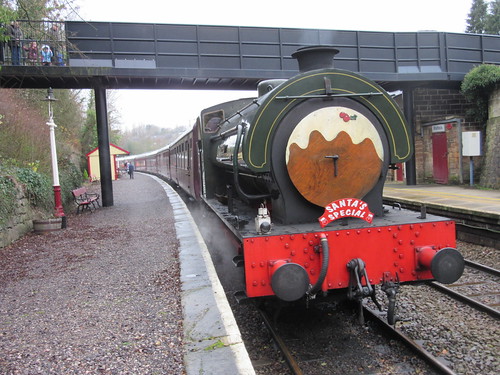 'Lord Phil' on arrival at Matlock Town, with 'Christmas Pudding' smokebox decoration and 'Santa's Special' headboard. It is displaying a tail lamp, ready for the return journey.
'Lord Phil' on arrival at Matlock Town, with 'Christmas Pudding' smokebox decoration and 'Santa's Special' headboard. It is displaying a tail lamp, ready for the return journey.
The 'Class 31' hauled the train back to Rowsley where Mike and I replenished the saddle tank. The water consumption is increased, of course, when supplying steam to heat the train. With the diners and booked passengers aboard, we set off on our second round trip. This was completed without incident, with Mike using the classic "little and often" method of firing. We didn't need to top-up with water this time.
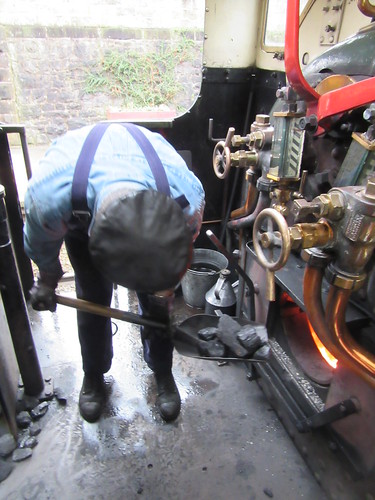
Mike using the classic "little and often" method of firing.
The train was very busy on the two round trips in the afternoon during which parties of adults arrived by, I think, at least four large motor coaches. After the third round trip, we filled the saddle tank, this time with me perched on top of the engine, allowing me to take a couple of pictures from my elevated position.
 A view of Rowsley whilst taking water. On the far left, the maroon exhibition coach is visible, stabled on the turntable siding.
A view of Rowsley whilst taking water. On the far left, the maroon exhibition coach is visible, stabled on the turntable siding.
On the last trip to Matlock, it was starting to grow dark so we lit the locomotive paraffin lamps, displaying a white near the chimney on the way there, changing to a red tail lamp on the buffer beam for the journey back. There's a little piece about lamps here.
 'Lord Phil' at Matlock Town, displaying a lit tail lamp.
'Lord Phil' at Matlock Town, displaying a lit tail lamp.
The 'Class 31' took us back to Rowsley for the last time, pausing briefly in the Down platform at Darley Dale. Now it was properly dark, the illuminated Christmas decorations on both platforms showed up well, encouraging a number of passengers to take photographs of the displays.
On arrival, we were given the single line token, allowing us to uncouple from the train and make our way, via the loop and third line, to the North end where we surrendered the token to the diesel crew, so that they could stable their locomotive in the shed on No. 1 road. Meanwhile, we took 'Lord Phil' to the siding outside the shed, so that Chris could coal our bunker using the Bucket Loader. We then made our way back to the North end and attached the exhibition coach from the turntable siding. With Jacob acting as guard, we propelled the coach over the third line back onto the loop. We then drew the coach along the loop, stopping where instructed adjacent to the main train. With the coach 'tied down' and uncoupled, it was now our turn to make our way to No. 1 road where we carried out the disposal procedures and stabled 'Lord Phil' over the outside pit.
Go to 'Santa Specials' at Peak Rail - Christmas 2015 (part 2)
My pictures
Peak Rail 'Santa' Trains - 2015.
This report is based on information from Doctor Hla Tun, who also supplied the photographs.
The previous report showing monthly statistics covered the period up to the end of October 2014, when the total number of treatments since the Clinic opened on August 6, 2011 was 118,801.
Treatment Summary
The table below summarises the number of treatments per month from November 2014 to October 2015 and the total number of treatments since the clinic opened on August 6, 2011 (missing figures will be added later).
In summary, at the end of October 2014 the Bagan Medical Clinic has been operating for 4 years and 3 months, carrying out a total of 159,680 treatments.
| Month |
Treatments in month |
Total treatments |
| November 2014 |
5,377 |
124,178 |
| December 2014 |
n/a |
n/a |
| January 2015 |
n/a |
n/a |
| February 2015 |
n/a |
n/a |
| March 2015 |
n/a |
139,502 |
| April 2015 |
1,320 |
140,822 |
| May 2015 |
2,484 |
143,306 |
| June 2015 |
3,070 |
146,376 |
| July 2015 |
4,706 |
151,082 |
| August 2015 |
2,863 |
153,945 |
| September 2015 |
2,935 |
156,880 |
| October 2015 |
2,800 |
159,680 |
General Notes
Water Festival/New Year
During April 2015, the Clinic closed for only one week during the important Water Festival and New Year.
Opthalmology
A lady opthalmologist who works in Chauk Hospital (about 20 miles from the Bagan Clinic) has started to treat patients in the Bagan Clinic every other Saturday.
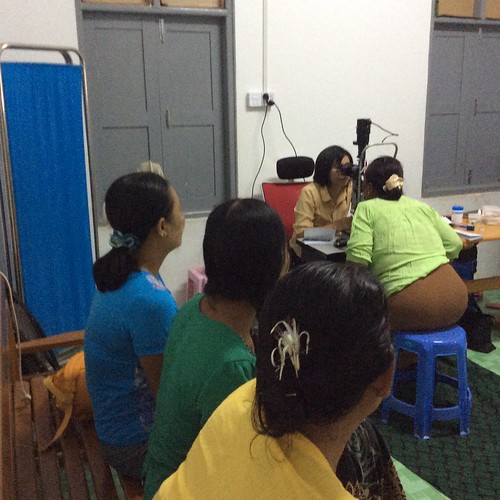 The Opthalmologist at work.
The Opthalmologist at work.
New Clinic Building
In October 2015, construction started on a further new clinic building in the Bagan Monastery
compound. This will provide an Eye Care Centre and X-ray facilities.
 The new building under construction.
The new building under construction.
A Young Patient
A young boy had mistaken pills for chocolate (because of their colour) with unfortunate results.
 A young patient.
A young patient.
Ethnic Groups in Burma
Burma comprises a number of distinct ethnic groups. Chin State, in the north west of Myanmar, is hilly and cooler. There is a tradition of eating dog meat as a protection against the cold. One Chin lady patient displayed facial tattoos. This tradition originated hundreds of years ago when a King wished to marry a beautiful Chin girl. Unwilling to be married to the King, the girl had tattoos to destroy her looks. The patient complained of difficulty eating because of inflammation resulting from the tattooing.
 Chin lady patient with facial tattoos.
Chin lady patient with facial tattoos.
An Elderly Brother and Sister
In October, an elderly brother and sister attending the clinic were given priority, because of their age. The lady was 90 and the man 92, survivors of a family of five brothers and sisters.
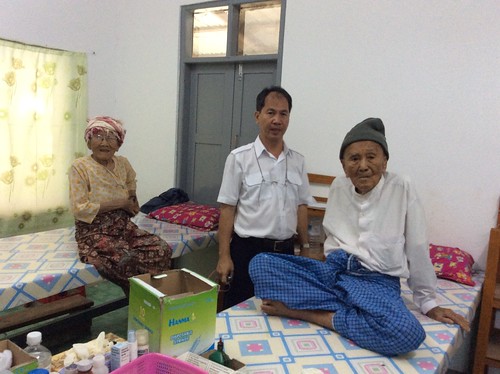 An elderly brother and sister.
An elderly brother and sister.
Donation of Reading Glasses
On 14th November 2014, around 100 patients received reading glasses in the Bagan Medical Clinic.
 Selection of reading glasses.
Selection of reading glasses.
Concert at Bagan Medical Clinic
Also on the 14th November 2014, 12 students gave a concert at the Bagan Medical Centre. 10 students danced, while a boy and girl performed a traditional comedy dance.
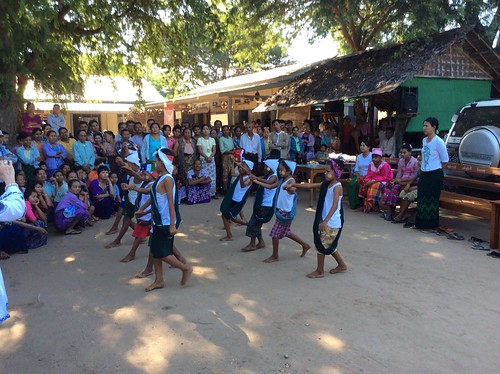 Ten students dancing.
Ten students dancing.
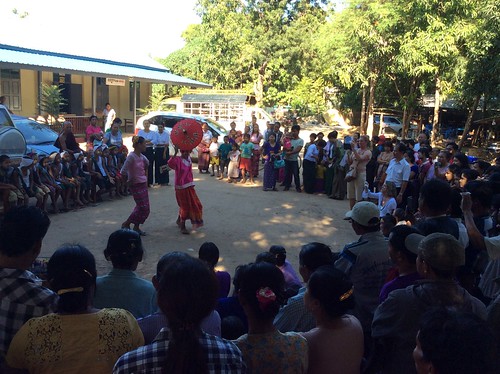 A boy and girl perform a traditional comedy dance.
A boy and girl perform a traditional comedy dance.
Donation of Walking Stick
A 91 year old lady with walking difficulty was given a walking stick by the clinic.
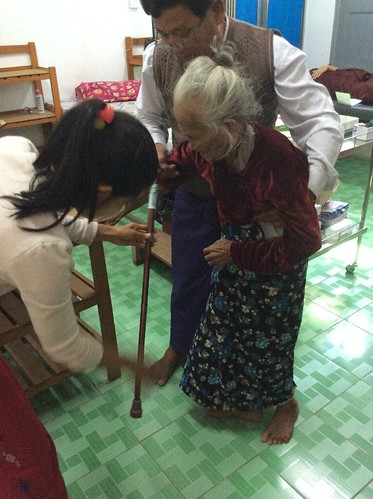
Donation of walking stick.
Free Lunches
With the continuing co-operation of the Abbot of Bagan Monastery and the 'Road to Mandalay' ship, lunch is served to patients and their companions on the clinic days (Friday, Saturday, Sunday).
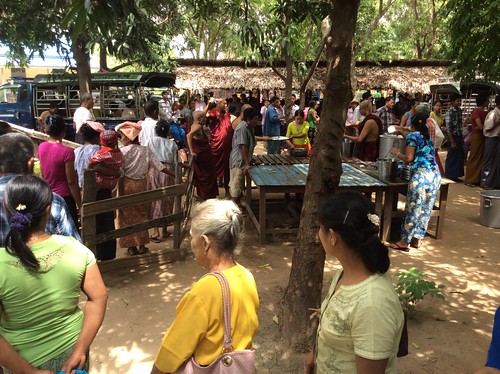 Free Lunch being served to waiting patients, under the watchful eye of the Abbot.
Free Lunch being served to waiting patients, under the watchful eye of the Abbot.
Other reports on medical support in Myanmar
There are a number of posts in this Blog describing medical support in Myanmar provided by the RTM Social Contribution with help from donors around the world. You can find them all here.
Photographs
There's a collection of pictures showing the Bagan Clinic from its inception here.
Doctor Hla Tun's photographs showing the work of the Bagan Clinic in 2014 are here and those taken in 2015 are here.
I'm afraid this report, covering the end of 2014 and 2015 is delayed (my fault), but in the interests of completeness, it's finally being issued. This report is based on information provided by Dr. Hla Tun, who also supplied the photographs.
Shwe Sin Minn
In October 2014, Dr. Hla Tun arranged for one of the guides working on the 'Road to Mandalay' ship to make a donation towards teachers' salaries at the Shwe Sin Minn Nunnery, Orphanage for Girls and Monastic Secondary School. Guests from the ship also donated rice, peanut oil, garlic and onions. Shwe Sin Minn is situated in Maymyo, up in the hills, around two hours driving from Mandalay. Maymyo was very popular with the British in summer, because of its cooler location.
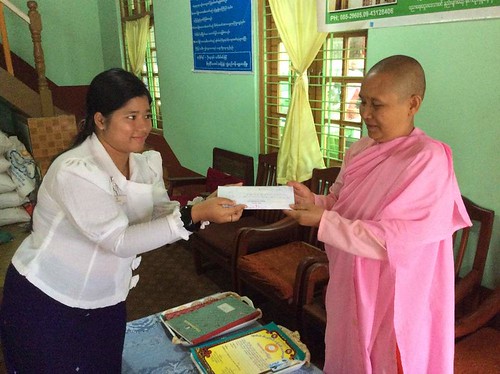 Teachers' salaries being donated to one of founders of Shwe Sin Minn.
Teachers' salaries being donated to one of founders of Shwe Sin Minn.
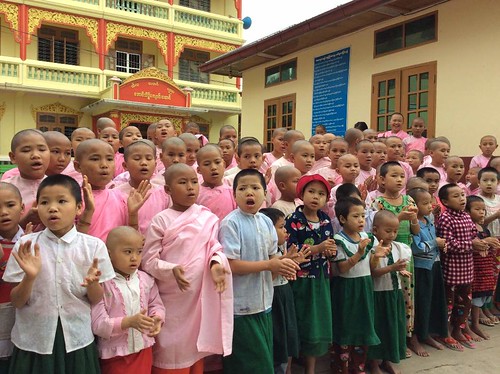 Girls at Shwe Sin Minn reciting a poem for their visitors.
Girls at Shwe Sin Minn reciting a poem for their visitors.
A report on my first visit to Shwe Sin Minn in 2011 is here My pictures of this visit and a later visit in 2013 are here.
Traditional Ceremonies
The following pictures show a procession in connection with traditional ceremonies. These are arranged in connection with Noviciation for boys and Ear Piercing for girls and feature decorated, gold-painted oxcarts.
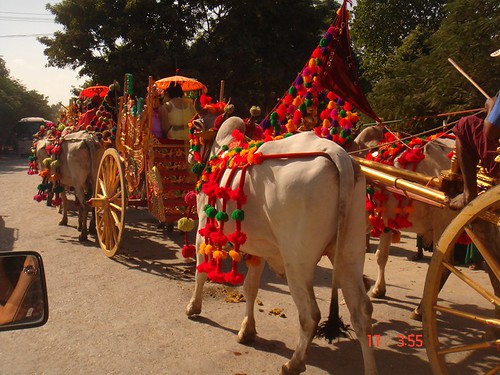 A procession of decorated oxcarts.
A procession of decorated oxcarts.
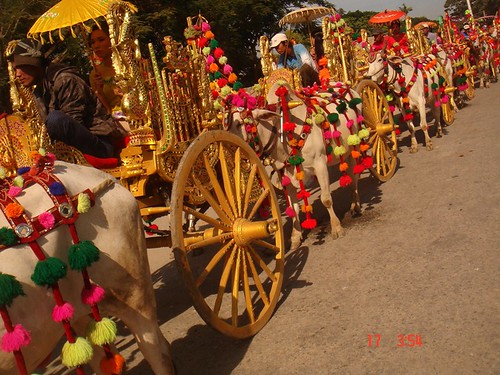 Another view of the procession.
Another view of the procession.
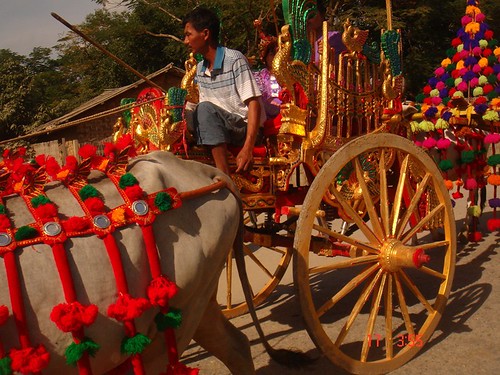 Close-up of one of the gold-painted oxcarts.
Close-up of one of the gold-painted oxcarts.
I'd been lucky enough the see this ceremony in 2012 at Moe Dar (report here), in 2013 at Bagan (briefly mentioned here) and in 2013 at Mandalay (briefly mentioned here).
Taung Be School Stationery Distribution and Concert
Taung Be school is only a few minutes walk from the Bagan Medical Clinic and the 'Road to Mandalay' landing stage in Bagan. On 25th October 2014 Dr. Hla Hun, accompanied by Guests from the ship, visited to distribute stationery to about 371 students. The picture below shows Grade 5 students from the school, dressed in traditional Shan Costume, performing a traditional dance from Inle Lake.
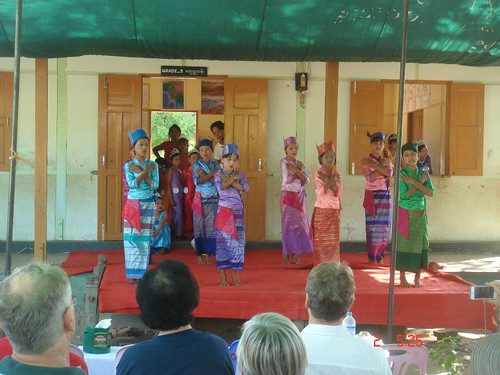 Taung Be Concert
Taung Be Concert
There's an earlier report on stationery distribution at Taung Be during 2013 here.
Aung Myae Oo Monastic High School
On 16th December 2014, Dr. Hla Tun visited this school in Sagaing which has 2,092 students from Grade 1 to Grade 11 of whom 691 are boys and novices and 1,401 are girls and nuns. There are 43 teachers on the staff.
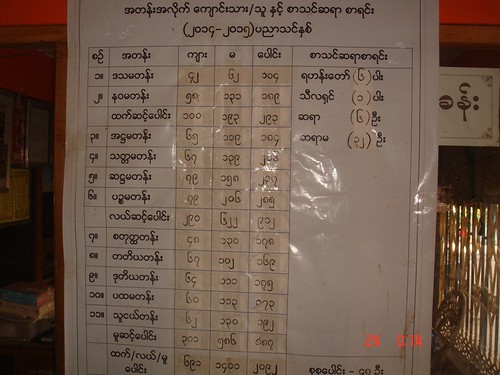 List of students.
List of students.
On that date, students from Grades 5 and 9, most of whom were nuns, were sitting their State Examinations.
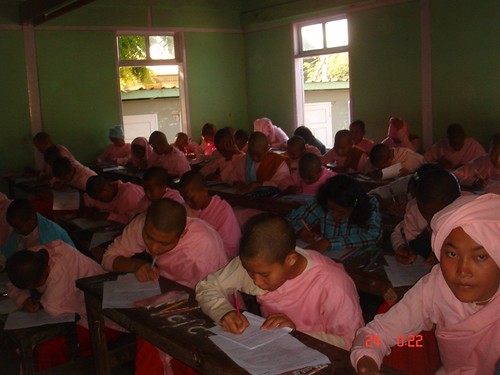 The State Examinations in progress.
The State Examinations in progress.
The Doctor made a donation to one of teachers, watched by small children (who were on holiday because of the State Examinations) and the Monk.
 Dr. Hla Tun making the donation.
Dr. Hla Tun making the donation.
Christmas Eve, 2014
On Christmas Eve, 15 orphans from Nar Ga and Tribal Orphanage, Mandalay, came on board the 'Road to Mandalay' to perform Christmas carols for the guests. The performers ranged from a 7 year attending Grade 3 to a 16 year in Grade 11. Among them, there are 6 orphans from the Nar Ga Tribe/Ethnic and 9 from the Chin Tribe/Ethnic. The group was led by a teacher, Ms. Ann Ja Taung who is also Chin Tribe/Ethnic.
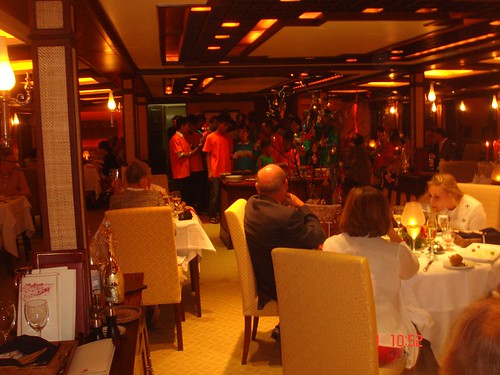 Singing carols to the Guests in the restaurant of the 'Road to Mandalay'.
Singing carols to the Guests in the restaurant of the 'Road to Mandalay'.
After the performance, Dr. Hla Tun made a donation to the Orphanage.
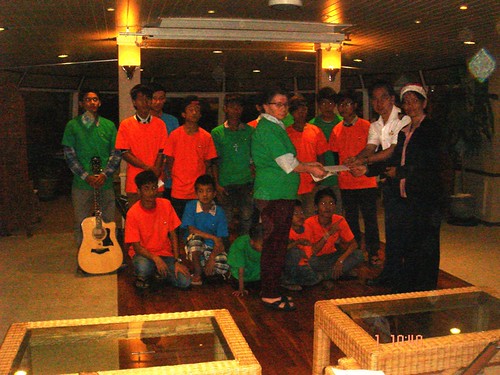 Dr. Hla Tun making a donation to the Orphanage.
Dr. Hla Tun making a donation to the Orphanage.
Ko Dut Drop In Centre
Donations have allowed improvements at this Drop In Centre in Mon State. The planned first floor has been brought into use by constructing a new floor and access stairs. The exterior has also been painted. These pictures, taken in February 2015, show the work in progress.
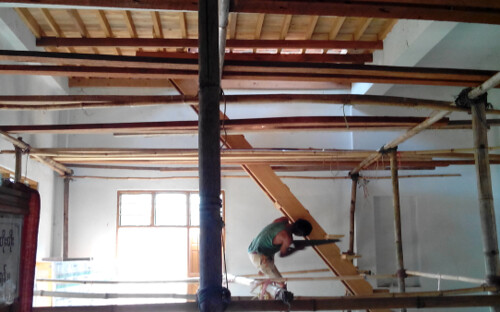 Ko Dut Drop In Centre: Improvements funded by donations - upper floor with access stairs being added.
Ko Dut Drop In Centre: Improvements funded by donations - upper floor with access stairs being added.
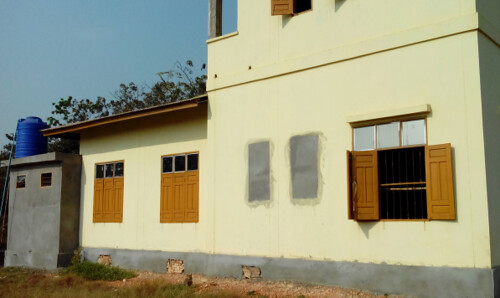 Ko Dut Drop In Centre: Improvements funded by donations.
Ko Dut Drop In Centre: Improvements funded by donations.
I first visited Ko Dut in 2014 and there is a report here. I returned in 2015 (and inaugurated the new upper floor by the simple process of sleeping on it) as described here.
All my posts on Educational Support in Burma can be found here.
Ty Gwyn is a small commercial woodland in north Wales extending to about 27 hectares (66 acres). When I first became involved the trees, mainly Sitka spruce and Lodgepole pine, were already fairly mature in various 'compartments' of different ages. You can find all my posts about Ty Gwyn here, with links to pictures.
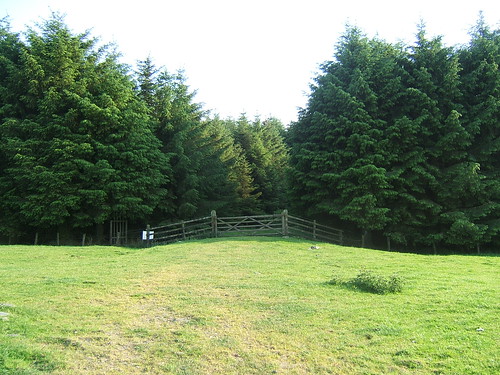 The entrance to Ty Gwyn in 2006.
The entrance to Ty Gwyn in 2006.
Timber extraction in 2009/2010
About half of the site was felled starting at the end of 2009. Because of poor weather condition, felling was not completed until 2010. That operation is described in the posts Harvesting at Ty Gwyn, Ty Gwyn ships out Timber and Progress on Harvesting at Ty Gwyn. The felled area was replanted with Sitka spruce and broadleaves to encourage bio-diversity. After a few months, the new planting was establishing well, as shown in the pictures here.
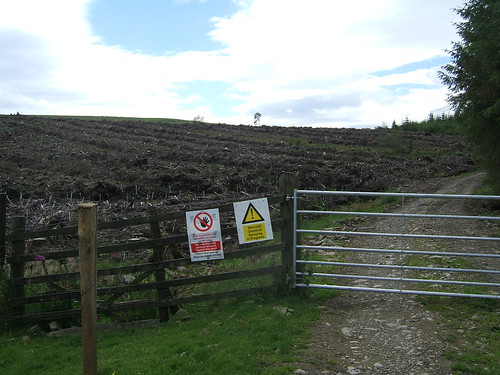 The entrance to Ty Gwyn in 2010, with the area on the left felled and re-planted.
The entrance to Ty Gwyn in 2010, with the area on the left felled and re-planted.
Timber extraction in 2014
Following an inspection visit in February 2014, it was decided to seek a Felling License for a further 10 hectares of mature trees. That's described in the post Ty Gwyn Update (with some rather belated notes regarding the completion of the felling and replanting in 2010).
The felling operation started in July 2014 and is described in posts Timber Extraction at Ty Gwyn and Harvesting continues at Ty Gwyn.
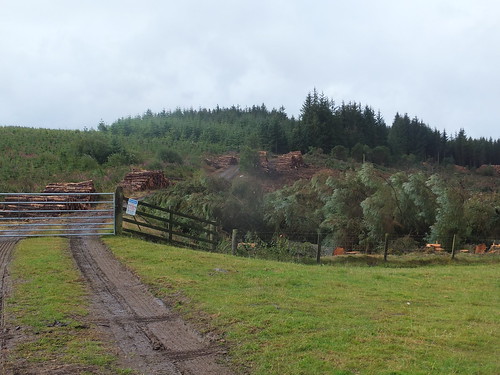 The entrance to Ty Gwyn in 2014, with the area on the left growing well and the newly-felled area on the right.
The entrance to Ty Gwyn in 2014, with the area on the left growing well and the newly-felled area on the right.
Replanting and Site Maintenance in 2015
On completion of the felling, 'Ground Preparation' was carried out, ready for re-planting. Although Rob, the forester, had originally hoped to re-plant early in 2015, for various reasons this did not occur until mid-November when around 18,000 Sitka spruce cell-grown seedlings were planted.
I visited Ty Gwyn on 26th November 2015 and met Rob and Gareth on site. Gareth had arrived that morning with his Volvo EC140CL excavator on a low-loader and had already cleared one of the access roads within the plantation. You can view Volvo's specification for the EC140 range of crawler excavators here.
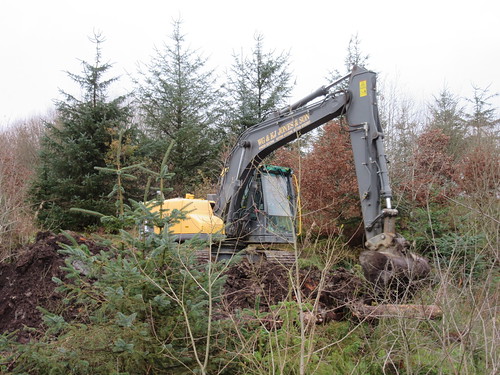 Maintenance being carried out by the excavator near the pool.
Maintenance being carried out by the excavator near the pool.
Although most of the re-planting had been carried out in very wet and windy conditions, I was lucky on my visit - rain earlier in the day had stopped, the wind had dropped and later in the day the sun came out.
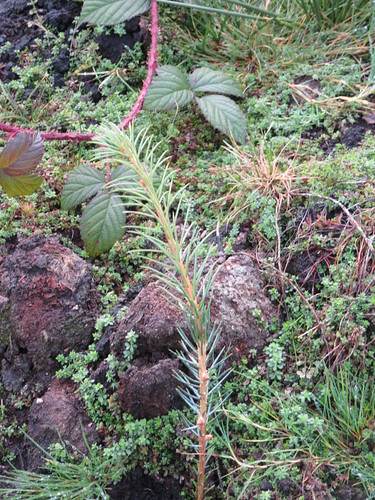
One of the new Sitka seedlings, just a few days after planting.
Pictures of Ty Gwyn
You can find all my pictures of Ty Gwyn here.
I'm afraid this report, covering the end of 2014 and 2015 is delayed (my fault), but in the interests of completeness, it's finally being issued.This report is based on information provided by Dr. Hla Tun, who also supplied the photographs.
Bagan Medical Clinic
As commented in earlier reports, the number of patients arriving for treatment tends to fall in summer, because the heat adds to the problems of travelling to the clinic. Winter in Burma is from November to February and Bagan has especially low temperatures because it is situated in the 'Dry Zone'.
The 'Dry Zone' is the name given to the microclimate of the region lying between the Shan Plateau to the east and the low coastal ranges to the west extending south from Mandalay and taking in much of the central plains where Bagan is situated. Because of this "rain shadow", Bagan and Mandalay receive, on average, less than one third of Yangon's yearly rainfall.
The Bagan Medical Clinic normally opens on Friday, Saturday and Sunday each week but patients from remote areas may have travelled up to 200 miles to reach the clinic and start to arrive as early in the week as Wednesday evening.
On the Thursday 18th December 2014 Dr. Hla Tun, assisted by two other doctors, started treating patients because there were already around 580 people waiting.
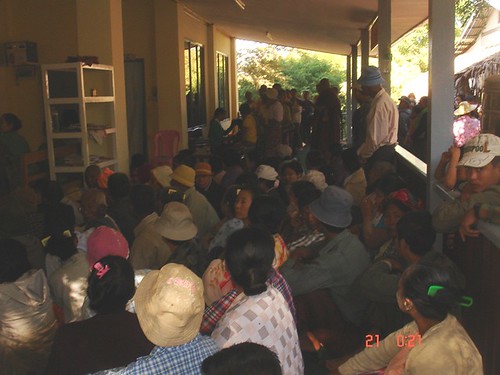 View of the verandah of the third (and currently largest) clinic building, showing some of the waiting patients.
View of the verandah of the third (and currently largest) clinic building, showing some of the waiting patients.
By the time Dr. Hla Tun stopped treatments for the day at one o'clock on Friday morning, the three doctors had dealt with 250 patients. As the night was cold, Dr. Hla Tun checked on the sleeping patients and took the pictures reproduced below. Although a substantial dormitory for waiting patients is now in use, donated by The Ultimate Travel Company and its clients, the large number of patients waiting for treatment meant that people were sleeping in a number of other areas, including the Monastery and its food store (along with dried onions, potatoes, chillies, garlic, carrots and cabbage).
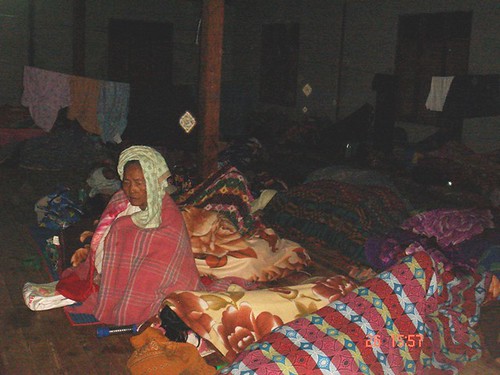 The Ultimate Travel Company and its clients donated a dormitory building for waiting patients in 2013. This picture (taken at 01:30 in the morning) shows about 70 patients, with one elderly lady unable to sleep because of the cold.
The Ultimate Travel Company and its clients donated a dormitory building for waiting patients in 2013. This picture (taken at 01:30 in the morning) shows about 70 patients, with one elderly lady unable to sleep because of the cold.
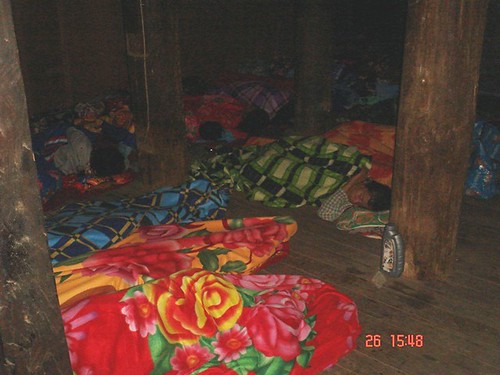 Patients sleeping in the upper storey of the 200-year old Monastery.
Patients sleeping in the upper storey of the 200-year old Monastery.
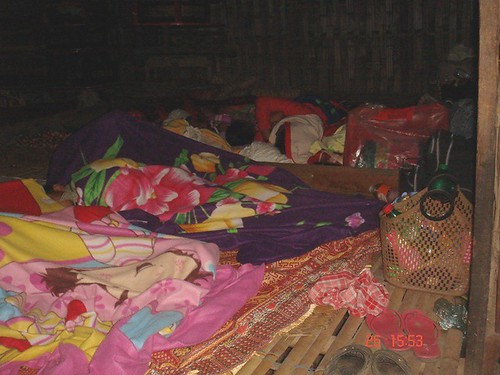 Patients sleeping in the Monastery food store.
Patients sleeping in the Monastery food store.
 A green carpet was laid on the floor in front of the clinic building to provide additional sleeping space.
A green carpet was laid on the floor in front of the clinic building to provide additional sleeping space.
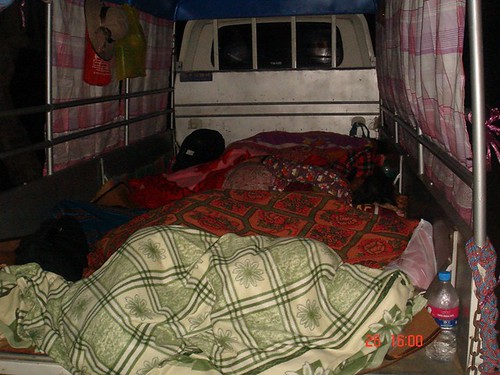 Waiting patients sleeping in a light truck, faces covered with blankets.
Waiting patients sleeping in a light truck, faces covered with blankets.
The monastery ensures that waiting patients are provided with a hot lunch each day. Preparing the food is a major undertaking - on the previous Saturday 13th December around 420 meals were served!
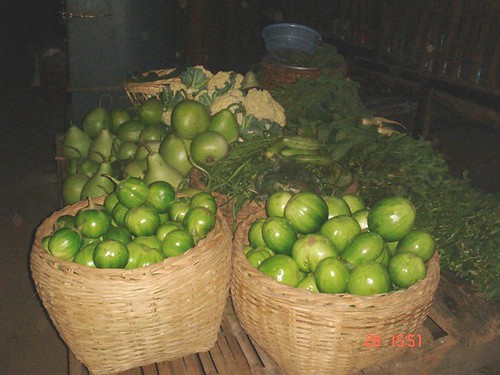 Vegetables will be mixed with dried fish and cooked by a monk assisted by volunteers to provide the free lunch for waiting patients at the Clinic.
Vegetables will be mixed with dried fish and cooked by a monk assisted by volunteers to provide the free lunch for waiting patients at the Clinic.
Bagan Medical Clinic treated 5377 patients in November 2014 bringing the total number of treatments carried out since the clinic opened on 6th August 2011 to 124,178.
You can find all my reports on the Bagan Medical Centre here.
 3205 Collett Goods at the Battlefield Line Steam Gala, October 2015
3205 Collett Goods at the Battlefield Line Steam Gala, October 2015
 Hunslet 3794 'Cumbria' at the Battlefield Line Steam Gala, October 2015
Hunslet 3794 'Cumbria' at the Battlefield Line Steam Gala, October 2015
 Jan relaxes on the footplate as 'Cumbria' pauses at Market Bosworth en route to Shenton with the 11:30 from Shackerstone.
Jan relaxes on the footplate as 'Cumbria' pauses at Market Bosworth en route to Shenton with the 11:30 from Shackerstone.

 James smiles for the camera at Market Bosworth on our second return trip to Shackerstone.
James smiles for the camera at Market Bosworth on our second return trip to Shackerstone.
 View from the platform at Market Bosworth as Santa visits each compartment of the 'De Luxe' train in turn.
View from the platform at Market Bosworth as Santa visits each compartment of the 'De Luxe' train in turn.















































